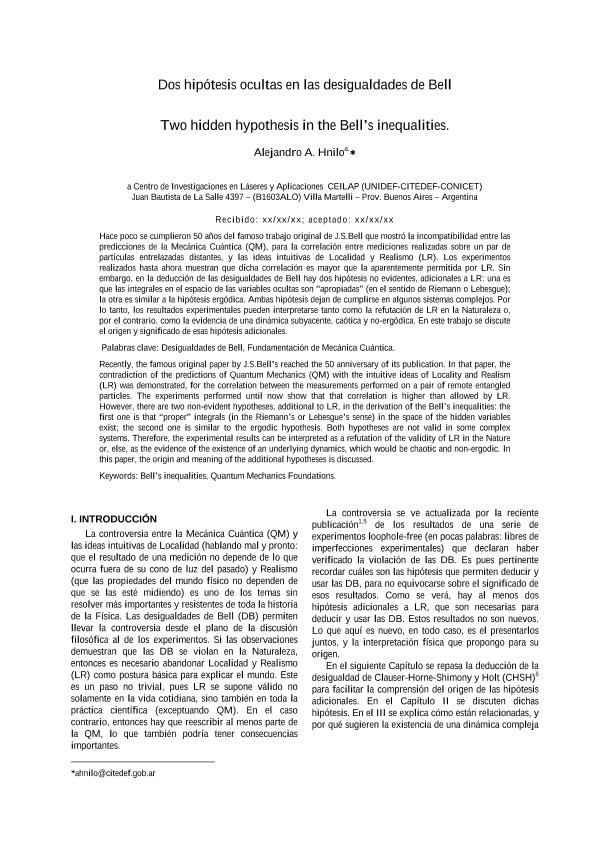Mostrar el registro sencillo del ítem
dc.contributor.author
Hnilo, Alejandro Andrés

dc.date.available
2018-05-07T18:31:45Z
dc.date.issued
2016-09
dc.identifier.citation
Hnilo, Alejandro Andrés; Dos hipótesis ocultas en las desigualdades de Bell; Asociación Física Argentina; Anales AFA; 27; 3; 9-2016; 109-114
dc.identifier.issn
0327-358X
dc.identifier.uri
http://hdl.handle.net/11336/44340
dc.description.abstract
Hace poco se cumplieron 50 años del famoso trabajo original de J.S.Bell que mostró la incompatibilidad entre las predicciones de la Mecánica Cuántica (QM), para la correlación entre mediciones realizadas sobre un par de partículas entrelazadas distantes, y las ideas intuitivas de Localidad y Realismo (LR). Los experimentos realizados hasta ahora muestran que dicha correlación es mayor que la aparentemente permitida por LR. Sin embargo, en la deducción de las desigualdades de Bell hay dos hipótesis no evidentes, adicionales a LR: una es que las integrales en el espacio de las variables ocultas son "apropiadas" (en el sentido de Riemann o Lebesgue); la otra es similar a la hipótesis ergódica. Ambas hipótesis dejan de cumplirse en algunos sistemas complejos. Por lo tanto, los resultados experimentales pueden interpretarse tanto como la refutación de LR en la Naturaleza o, por el contrario, como la evidencia de una dinámica subyacente, caótica y no-ergódica. En este trabajo se discute el origen y significado de esas hipótesis adicionales.
dc.description.abstract
Recently, the famous original paper by J.S.Bell's reached the 50 anniversary of its publication. In that paper, the contradiction of the predictions of Quantum Mechanics (QM) with the intuitive ideas of Locality and Realism (LR) was demonstrated, for the correlation between the measurements performed on a pair of remote entangled particles. The experiments performed until now show that that correlation is higher than allowed by LR. However, there are two non-evident hypotheses, additional to LR, in the derivation of the Bell's inequalities: the first one is that "proper" integrals (in the Riemann's or Lebesgue's sense) in the space of the hidden variables exist; the second one is similar to the ergodic hypothesis. Both hypotheses are not valid in some complex systems. Therefore, the experimental results can be interpreted as a refutation of the validity of LR in the Nature or, else, as the evidence of the existence of an underlying dynamics, which would be chaotic and non-ergodic. In this paper, the origin and meaning of the additional hypotheses is discussed.
dc.format
application/pdf
dc.language.iso
spa
dc.publisher
Asociación Física Argentina

dc.rights
info:eu-repo/semantics/openAccess
dc.rights.uri
https://creativecommons.org/licenses/by-nc-sa/2.5/ar/
dc.subject
Desigualdades de Bell
dc.subject
Fundamentos de Mecánica Cuántica
dc.subject.classification
Otras Ciencias Físicas

dc.subject.classification
Ciencias Físicas

dc.subject.classification
CIENCIAS NATURALES Y EXACTAS

dc.title
Dos hipótesis ocultas en las desigualdades de Bell
dc.title
Two hidden hypothesis in the Bell's inequalities.
dc.type
info:eu-repo/semantics/article
dc.type
info:ar-repo/semantics/artículo
dc.type
info:eu-repo/semantics/publishedVersion
dc.date.updated
2018-05-04T14:55:35Z
dc.journal.volume
27
dc.journal.number
3
dc.journal.pagination
109-114
dc.journal.pais
Argentina

dc.journal.ciudad
Tandil
dc.description.fil
Fil: Hnilo, Alejandro Andrés. Consejo Nacional de Investigaciones Científicas y Técnicas. Instituto de Investigaciones Científicas y Técnicas para la Defensa. Centro de Investigación en Láseres y Aplicaciones; Argentina
dc.journal.title
Anales AFA

dc.relation.alternativeid
info:eu-repo/semantics/altIdentifier/url/http://anales.fisica.org.ar/journal/index.php/analesafa/article/view/2105
dc.relation.alternativeid
info:eu-repo/semantics/altIdentifier/url/http://ref.scielo.org/n7sgk8
Archivos asociados
